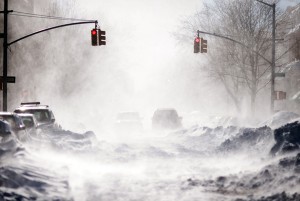By Rachelle Oblack | From About.com
 Knowing how to survive a blizzard or other winter storm is a crucial, (though hopefully unused) bit of knowledge everyone should know. There are multiple types of winter storms and each can be deadly killers. While men are more likely to die in a winter storm as can be seen in these winter storm death statistics, there are risks for everyone. Imagine being snowed into your house or being stranded in a car during a blizzard. Would you know how to survive? Here, this advice could save you life.
Knowing how to survive a blizzard or other winter storm is a crucial, (though hopefully unused) bit of knowledge everyone should know. There are multiple types of winter storms and each can be deadly killers. While men are more likely to die in a winter storm as can be seen in these winter storm death statistics, there are risks for everyone. Imagine being snowed into your house or being stranded in a car during a blizzard. Would you know how to survive? Here, this advice could save you life.
How to Survive a Winter Storm…
Outside
- Seek some form of shelter immediately. Blowing winds can cause the wind chill to reduce your core body temperature to dangerous levels. The risk of frostbite and hypothermia increase every minute you are exposed to the cold weather.
- If you are wet, try to get dry. Lighting a small fire will not only provide warmth, but will enable your clothing to dry out.
- Deep snow can actually act as an insulation from the wind and cold temperatures. Digging a snow cave can actually save your life.
- Stay hydrated, but do not eat snow. You need to melt snow before eating it. Your body must still heat the ice and melt it. Instead, gather snow in some sort of vesicle and attach it to your body for a slow melting process. A canteen inside your coat, but not directly next to the skin will speed the melting process.
In a Car or Truck
- Never leave the vehicle. If you are stranded, the vehicle offers a form of protection from overexposure to the cold. A single person walking through the snow is also harder to find than a stranded car or truck.
- It is okay to run the car for short periods to provide some heat. Remember to crack the windows a small amount to allow for the circulation of fresh air. Dangerous exhaust fumes, including carbon monoxide, can build up very quickly. This is especially true if the tailpipe is buried in the snow.
- Keep yourself moving. A car offers little room for you to keep your blood flowing, but exercise is a must. Clap your hands, stomp your feet, and move around as much as possible at least once an hour. In addition to keeping your body moving, keep your mind and spirit from wandering too far into gloom. While potentially dangerous situations are not a time of joy, keeping yourself from added stress will allow you to make smarter decisions when necessitated.
- Make the car visible for a rescue. Hang bits of bright colored cloth or plastic from the windows. If the snow has stopped falling, open the hood of the car as a signal of distress.
At Home
- If the electricity goes out, use an alternative form of heat with caution. Fireplaces and kerosene heaters can be dangerous without proper ventilation. Keep children away from any alternative heat source.
- Stick to one room for heat and close off unnecessary rooms in the house. Make sure there are no air leaks in the room. Keep sunlight streaming through the windows in the day, but block all windows at night.
- Keep hydrated and nourished in case the heat is out for an extended period. An unhealthy body will be more susceptible to the cold than a healthy one.
- Pets must also be protected from the cold. When temperatures drop below freezing, outdoor pets should be moved indoors or to a sheltered area to protect them from the cold.
Other Tips for Winter Weather Safety
Always have a winter weather emergency kit available. Ideally, you should create an emergency kit for your home and your car. If you have small children, remember to actually practice using the kits. In the event of a winter emergency, kids should know where the kit is located and how to use the kit. You may want to try the Family Disaster Quiz to determine how prepared your family is for a weather emergency.
In addition to having a winter safety kit, all family members should be able to recognize the signs of hypothermia and basic first aid treatment for cold exposure.
Finally, if your region is prone to winter storms of any type, you are encouraged to buy a weather radio or scanner in the event of an emergency. Multiple types of winter weather advisories each have their own dangers.
—
This article was originally posted at: http://weather.about.com/od/winterweather/a/winter_survival.htm







